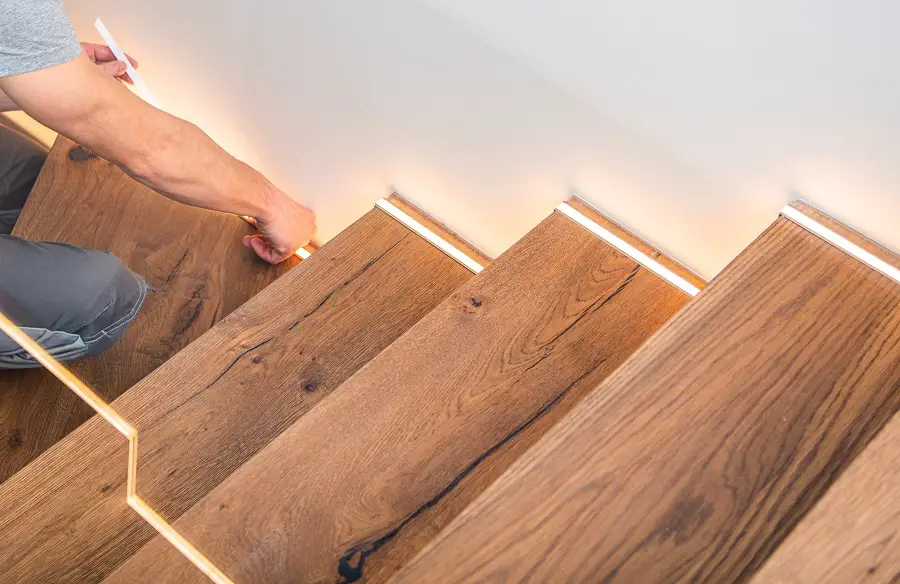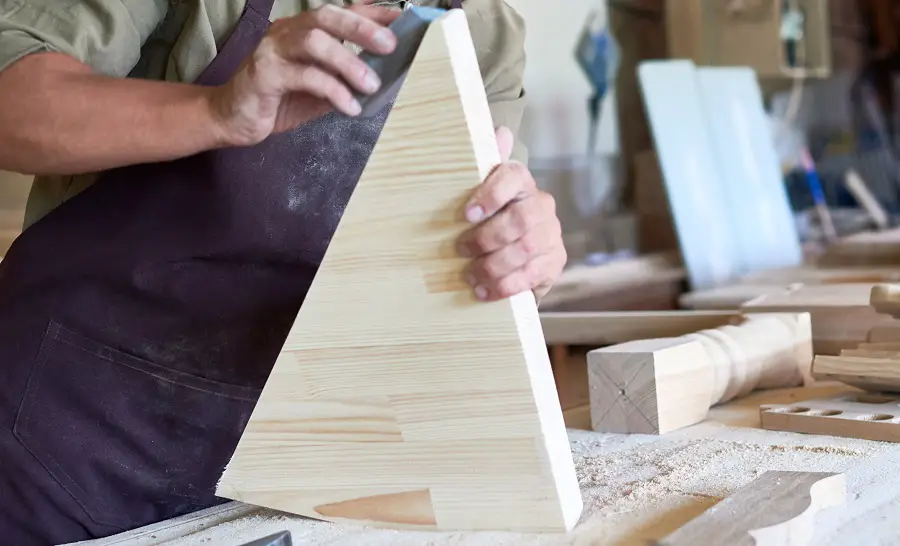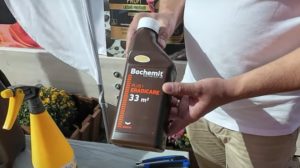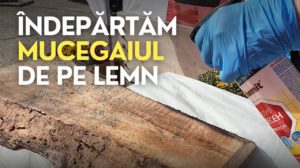I received such a question as a comment on one of the articles. As it required a more elaborate answer, I thought it might be of use to others who are faced with wood staining problems and don't know what to choose from the countless products they can find in the shops, both physical and online. The presentation made reference to the fact that the wood - solid fir - had been left outside to dry for years, was raw, untreated and unstained. Advice was sought on both staining and protecting the steps to be installed on a low-traffic interior staircase.

How to stain wood to keep the grain visible
The classic method of protecting wood so that the grain remains visible is with dye-based stains and clear lacquers. Dye-based stains are staining solutions made from thinners or water and soluble dyes. When applied directly to the wood, they are absorbed and bring out the natural design. In contrast to these solutions, there are pigment stains. These do not dissolve in water or thinner, they remain in suspension, and when applied to the wood they remain on the surface, giving a more uniform but less spectacular color, with the grain less visible. Semi-transparent pigment staining is mainly used outdoors (lazuri) because the pigments not only make the finish uniform, but also make it resistant to UV radiation. They are also used when the wood absorbs differently and stains or when the object, in this case the staircase, is made of different wooden elements and an ordinary stain would unpleasantly highlight the differences between them.
Stain stains can be water-based or solvent-based. Water-based stain varnishes absorb better into the wood and highlight the grain better. The disadvantage is that by absorbing water, the wood grain lifts and more vigorous sanding will be needed afterwards to achieve a smooth to the touch surface. Solvent-based polishes absorb less into the wood and give a duller appearance. The grain, however, will lift much less. Regardless of the type of stain, if over-applied and followed by wiping with a rag, the natural wood grain will be marred.
In this case, an oak-colored bath will be used. The treads are not fitted, so a solvent-based stain can be used, avoiding raising the fibers without bringing the lingering smell of thinner into the house. You can find such wood polishes in hardware stores or stores that carry wood finishing supplies. There are several types of oak balsam, so it's a good idea to check the color before using it. There is dark oak, light oak, medium oak, golden oak, antique oak, etc. Check the label and buy the one that has only dye and solvents. If you want the grain of the wood to stand out, don't buy baths that have pigments or significant resin additions.
After the varnish has been applied and dried, the first coat of varnish is applied, without sanding, even if the wood grain has risen and feels unpleasant. Sanding at this stage can spoil the uniformity of color. Sand after the first coat of varnish has dried. As it is a stair, we recommend the use of a solvent- or water-based floor varnish. It can be applied with a trowel. If you use solvent-based varnish, choose a solvent-resistant sponge.
Coloring can also be done with colored varnish
For those who want an easier way to get away without many coats and materials, there is the option of using an oak colored floor lacquer. Be careful, lacquer not paint, so that the wood grain remains visible. In general, commercially available colored varnishes have hardnesses suitable for furniture. If you want a harder varnish, you can make your own. The varnish must be compatible with the varnish in question (water with water and solvent with solvent). With solvent-based varnishes, check compatibility beforehand. It is possible that some dyes are not soluble in all the solvents in the varnish thinner and the color may change.
To color the varnish, add up to 10% bath. Even if the varnish is very diluted, it is not good to add more because it will dilute the varnish and the application will be more difficult (drips will appear). It is better to make the color lighter than desired, and the final color should result from the successive coats applied.
Application should be done carefully and evenly to avoid color streaks. The color will also darken with each coat applied. To avoid this effect, 1-2 colored coats can be applied until the desired color is reached, then continue with clear lacquer.

Sanding, very important to achieve even coloring and a pleasant surface to the touch
The success of solid wood staining depends on proper sanding. Proper sanding before applying the wood stain will make the wood absorb evenly, and the coloring will be uniform, without spots. If the wood is very rough, sand it successively with 2 different grits, for example first with a 120 grit paper, then 150 or first 150, then 180. After sanding, the wood is thoroughly sanded before applying the staining solution.
Equally important sanding between coats. It ensures not only a smooth surface but also good adhesion between coats. Sand after the first coat of varnish is completely dry. When staining the wood, the grain of the wood is slightly raised, and after varnish application, this raised grain becomes very hard and scratchy. To remove it and obtain a surface that is pleasant to the touch, sand the surface with 280 or 320-grit sandpaper or a fine sanding sponge. Do not sand after sanding as this will spoil the color uniformity.
Even though the color will be identical to oak, the final look of the stained fir will not be oak
I must draw attention to something I have come across many times. Those who use oak, walnut, or mahogany to color resinous wood (spruce, pine, fir, larch), the wood is expected to look like spruce, pine oak, nuc or mahon. It won't look the same because the natural grain pattern is different, and resinous wood has no pores. The lack of pores makes the look very different.
So, even if the stain used for the stair treads is oak, the stairs will not look like oak at the end, but like yellow-brown stained fir.
Wood acclimatisation indoors
And one more thing to be aware of when using wooden floors or steps that have been outside for a long time or stored in rooms with different humidity than indoors. Before finishing and installation, the wooden elements should be kept indoors for a few days to allow their moisture to reach in balance with indoor humidity. This avoids stresses in the wood after finishing, which can cause the wood to move and the varnish to crack.
I hope you find the information useful. If you have any clarifications or questions, leave them below in the dedicated space. I will certainly reply.




































I hope you will write an article, in the future, about how we can make wood totally waterproof. What solutions do we have on the market, in Romania, so that the fiber remains visible and is also healthy for the wood in time.
Hello!
I have written about protecting wood from water on other occasions. It depends on where that wood will be used.
I'll come back to the subject, but I'd like to know where that wood will sit so I know what conditions the materials used must meet. It is very hard to find a universally valid material.
All the best!
Mrs Radu thank you very much for this article! It is very useful to me because I am in a similar situation. However please give me some advice.
I have purchased prefabricated oak treads and risers from the local stores, all of which are finished but have no protective coating applied. I want to fit them myself and want to be sure that after fitting they have a nice furniture like appearance. Some of the steps and risers need to be cut before fitting.
1. Should I treat them completely before cutting and mounting? Baitz and solvent-based floor varnish. The steps can be painted perfectly on the bench and the paint will be uniform, the only problem is the cut areas.
2 Treat them completely after fitting? In this way there is no risk of damaging the treatment during cutting, but there is a risk of scratching or staining the wood during assembly. Also the painting process presents risks at the skirting boards and at the joint between the risers and the treads.
3. I'm thinking of a mix of the 2 above. Namely the application of 2 coats of baitz (in the desired colour) followed by cutting and installation, and once installed the application of a coat or 2 of floor varnish.
Your opinion would help me a lot.
None of the tradesmen wanted to tell me how to do it because that's how they justified the huge fitting price.
Hello,
Please help me with some advice on varnishing some pine steps.
We have had the steps fitted in the house for approx 12 years and they have been bathed and varnished.
Now we wanted to freshen up the air in the house 🙂 so we sanded the steps (80 grit) and wanted to lacquer them but be able to keep the natural colour of freshly sanded pine wood ... and not wet pine wood (as is generally the case - even if you lacquer them with clear lacquer ... the colour gets a little yellowish ... instead of light cream)
What do you recommend?
Thank you very much!
Liviu Georgescu
Hello!
Unfortunately, you won't be able to keep the colour immediately after sanding. Pine wood naturally turns yellow, it changes colour no matter what it is coated with.
What you can do is reduce this change and not add the slightly yellowish tint that some varnishes have.
As far as varnishes are concerned, the ones that best preserve the natural colour are solvent-based acrylic varnishes (also called natural-effect varnishes). You can find them at professional wood products distributors - Sayerlack (Golda), ICA (Lomilux), Sirca, Renner, Remmers (Golda), Milesi. They also offer UV absorbers. These are products that are added in small quantities to varnishes and reduce the natural yellowing of wood caused by light. But don't use special outdoor varnishes because they are lightly coloured and change the wood's tint.
Another solution is to coat the wood with a wood-coloured stain (the light cream you want), a very light stain that imperceptibly covers the wood. You should use a uniforming wood stain (also available from the above retailers). Then apply varnish without natural effect. This way, the change in colour of the wood will be very small and hardly noticeable.
Good luck!